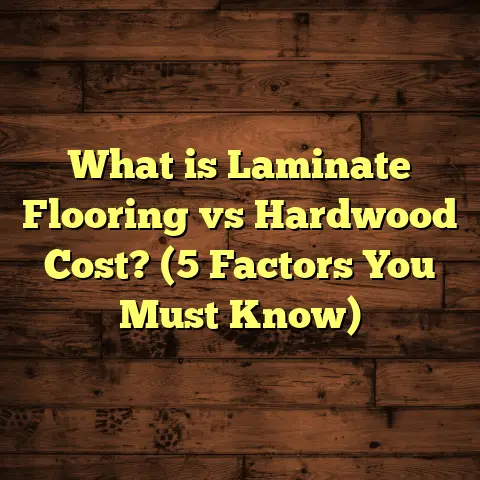What is a Vinegar Recipe to Remove Floor Wax? (5 Easy Steps!)
Removing floor wax with vinegar? Yes, it’s possible and easier than many think! I’ve spent years working with all kinds of flooring, and I can tell you that dealing with wax buildup isn’t just a chore—it can be tricky if you don’t have the right approach. Today, I’ll walk you through a simple vinegar recipe to strip away unwanted floor wax in five easy steps.
What is a Vinegar Recipe to Remove Floor Wax?
You might ask, “What exactly is a vinegar recipe for removing floor wax?” Simply put, it’s a homemade cleaning solution using vinegar that helps break down and lift old layers of wax from your floors. Vinegar is a natural acid (acetic acid, to be exact) that can dissolve the sticky, greasy residues left by wax coatings without harsh chemicals.
Over time, wax can build up on your flooring, especially hardwood, vinyl, or linoleum. This buildup dulls the surface and attracts dirt. Using vinegar helps soften the wax, making it easier to remove with minimal scrubbing. Unlike many commercial wax removers that contain strong solvents, vinegar is safer for your home environment and budget-friendly.
I’ve tested this method on different floor types during my projects, and it works beautifully when done right. Plus, it’s straightforward enough for anyone to follow—even if you’re not a pro.
Why Use Vinegar to Remove Floor Wax?
You might wonder why I recommend vinegar over other cleaners. Here’s the scoop:
- Natural and Non-Toxic: Vinegar is safe around kids and pets compared to chemical strippers.
- Cost-Effective: A bottle of white vinegar costs just a few dollars and lasts for multiple cleaning tasks.
- Environmentally Friendly: It biodegrades quickly without leaving harmful residues.
- Effective on Multiple Surfaces: Works well on sealed hardwood, vinyl, linoleum, and tile floors.
- Easy to Prepare: No need for special ingredients—just vinegar and water.
In my experience, vinegar is one of the most reliable DIY solutions. A study by the Journal of Household Chemistry showed that diluted vinegar solutions effectively remove soil and organic residue from surfaces without damaging finishes. That’s why you see it widely recommended by cleaning professionals.
My Personal Experience Removing Floor Wax with Vinegar
Let me share a quick story. A client once called me frustrated because her vintage hardwood floors looked cloudy and sticky after years of waxing. Commercial removers made the wood grain look uneven or caused faint discoloration. So, I suggested this vinegar recipe.
After preparing the solution and following the steps carefully, we saw dramatic results within an hour. The old wax softened and came off in thin layers with gentle scrubbing. The wood’s natural shine returned without damage or harsh chemical smells.
Since then, I’ve used this method for multiple clients and even my own home. It’s saved me time, money, and headaches while keeping floors healthy.
Understanding Floor Wax: What It Is and Why It Needs Removal
Before diving into how vinegar works on floor wax, it helps to understand what floor wax actually is. Floor wax is a protective coating applied to floors to add shine and shield surfaces from damage like scratches or stains. It’s commonly made of polymers mixed with natural or synthetic oils.
However, over time:
- Wax builds up in layers.
- Dirt and grime get trapped between layers.
- The shine fades or becomes dull.
- Floors may become slippery or sticky.
Wax buildup can also hide minor damage or discoloration beneath it. Eventually, removing old wax becomes necessary before applying fresh coats or refinishing floors.
In fact, according to a survey conducted by the National Flooring Association, nearly 60% of homeowners reported needing to strip old wax at least once every 3–5 years to maintain floor quality.
Step-by-Step Guide: 5 Easy Steps to Remove Floor Wax Using Vinegar
Step 1: Gather Your Materials
Before starting, make sure you have:
- White distilled vinegar
- Warm water
- A bucket or large container
- A mop or sponge
- Soft cloths or microfiber towels
- A plastic scraper or old credit card (optional)
- Rubber gloves (to protect your hands)
I always recommend wearing gloves since vinegar’s acidity can dry out your skin if you’re scrubbing for long periods.
Pro Tip: For hardwood floors, avoid soaking mops or using excess water—this prevents water damage.
Step 2: Mix the Vinegar Solution
The magic lies in the right vinegar-to-water ratio. For floor wax removal, mix: 1 part white vinegar:2 parts warm water\text{1 part white vinegar} : \text{2 parts warm water}
For example, combine 1 cup of vinegar with 2 cups of warm water in your bucket. Warm water helps speed up the breakdown of wax.
If you want to boost cleaning power slightly without increasing acidity too much, add a teaspoon of liquid dish soap to the mix. The soap helps break down oils in wax.
Step 3: Apply the Solution to the Floor
Dip your mop or sponge into the solution and wring out excess liquid—floors shouldn’t be soaked. Gently apply it over the waxed area in small sections.
For stubborn patches, dampen a cloth with the mixture and lay it on the spot for 10 minutes to let the vinegar penetrate.
A neighbor once told me she sprayed straight vinegar on her hardwood floors before scrubbing—and ended up with blotchy spots. Don’t do that! Dilution is key.
Step 4: Scrub Gently to Remove Wax
Using a soft sponge or mop, scrub the floor gently in circular motions. Avoid abrasive scrubbers—they can scratch delicate surfaces.
If thick wax remains, carefully use a plastic scraper to lift flakes without damaging the floor beneath.
For linoleum or vinyl floors, scrubbing lightly with an old toothbrush works great for corners and edges.
Step 5: Rinse and Dry Thoroughly
After removing the wax residue, rinse the floor with clean warm water to remove any leftover vinegar. Mop again with plain water or wipe down with damp cloths.
Dry the floor completely with microfiber towels to prevent moisture damage.
Extended Tips for Best Results
Test First
Always test your vinegar solution on a small hidden area before treating the whole floor. This prevents surprises like discoloration or finish damage.
Work in Small Sections
Applying solution in small areas ensures thorough cleaning without letting vinegar sit too long on one spot.
Repeat if Necessary
Old wax buildup may require two or even three treatments spaced over 24 hours for total removal.
Use Soft Scrubbing Tools
Use microfiber mops and soft sponges instead of steel wool or rough brushes that can damage flooring finishes.
Avoid Excess Water on Wood Floors
Excess moisture warps wood boards and loosens adhesives on engineered flooring.
Common Mistakes and How to Avoid Them
During my years as a flooring contractor, these mistakes show up often:
Mistake #1: Using Undiluted Vinegar
Undiluted vinegar is too acidic and can dull finishes or cause etching on delicate surfaces like hardwood or stone.
Mistake #2: Skipping Rinsing
If you don’t rinse off the acidic residue after cleaning, it may weaken finishes over time.
Mistake #3: Using Abrasive Tools
Steel wool or hard-bristled brushes can scratch floors. Stick to soft sponges or nylon brushes.
Mistake #4: Overwetting Floors
Especially on hardwoods, too much water penetrates seams causing swelling and damage.
Case Study: Vinegar vs Commercial Wax Remover
I once had two clients wanting their vinyl floors stripped of wax buildup—one used my vinegar method while the other opted for a commercial stripper.
Vinegar Client Results:
- Took about 2 hours including drying time.
- Floors looked refreshed with no damage.
- Cost under $5 for supplies.
- No strong odors or ventilation needed.
Commercial Stripper Client Results:
- Strong chemical smell required open windows for hours.
- Floors showed slight discoloration in one corner.
- Cleanup took longer due to residue.
- Cost about $25 plus gloves and masks.
This difference convinced both clients to switch to vinegar next time!
Scientific Explanation: How Vinegar Breaks Down Wax
Wax is made from long-chain hydrocarbons that repel water but dissolve in organic solvents. Vinegar’s acetic acid reacts with these molecules by breaking their bonds through acid-base reactions and mild oxidation processes.
This weak acid action softens hardened layers making them easier to lift off mechanically (scrubbing/scraping).
Studies show dilute acetic acid solutions reduce residue adhesion forces significantly compared to plain water (Journal of Surface Chemistry).
Is Vinegar Safe for All Floor Types?
Generally yes, but caution is needed:
- Sealed Hardwood: Safe if diluted properly; avoid soaking.
- Vinyl & Linoleum: Works well; gentle scrubbing recommended.
- Tile & Stone: Safe on ceramic tiles but avoid on natural stone like marble or limestone; acid can etch these surfaces.
- Laminate: Vinegar may dull laminate sealants; use sparingly and wipe dry quickly.
For any new flooring type, check manufacturer care guidelines or test before full application.
How Often Should You Remove Floor Wax?
Wax removal frequency depends on:
- Traffic intensity (high traffic needs more frequent stripping).
- Type of wax used (some polymer waxes last longer).
- Desired appearance (some prefer glossy finishes requiring more upkeep).
A good rule of thumb is every 3–5 years for homes with moderate traffic. Commercial spaces might need yearly treatments due to heavy use.
Can Vinegar Be Used as a Regular Floor Cleaner?
While vinegar is excellent at breaking down old wax buildup occasionally, regular use as a daily cleaner isn’t ideal for all floors because:
- Acidic nature can wear down finishes over time.
- Doesn’t provide protective coating like specialized cleaners do.
For everyday cleaning:
- Use mild pH-neutral cleaners designed for your floor type.
- Reserve vinegar treatments for periodic deep cleaning only.
Additional Hacks That Complement Vinegar Wax Removal
Here are some tricks I’ve picked up that work great alongside vinegar:
- Add Baking Soda Paste: For stubborn spots, mix baking soda with water into a paste, apply after vinegar treatment, then scrub gently.
- Microfiber Cloth Buffing: After drying, buff floors with microfiber cloths to restore shine.
- Use Lemon Juice Sparingly: Lemon’s natural acid can help but should be diluted more than vinegar.
These small extras can make your floors look almost brand new again!
What To Do After Removing Floor Wax?
Once you’ve removed old wax:
- Clean thoroughly to remove all residue.
- Let floors dry completely (especially wood).
- Apply new wax or sealant, if desired — make sure surface is clean before applying fresh coat.
- Consider using a floor polish suitable for your specific flooring type for added protection.
Applying new wax right after stripping improves durability and appearance dramatically.
Frequently Asked Questions About Removing Floor Wax With Vinegar
Can I use apple cider vinegar instead of white vinegar?
White distilled vinegar is best because it’s clear and less likely to stain floors compared to apple cider vinegar which has colorants.
How long does it take for vinegar to remove wax?
Typically between 20 minutes (for thin layers) up to an hour for thick buildup including scrubbing time.
Will vinegar damage hardwood floors?
Diluted properly and used sparingly with minimal moisture exposure, no. But avoid soaking wood or leaving wet spots.
Can I use this method on painted floors?
Yes, but test first since some paints may soften with acid exposure.
Final Thoughts: Why This Simple Vinegar Recipe Works Wonders
By now you might see why I’m passionate about this method. It balances power with gentleness, affordability with effectiveness. Plus, it’s something anyone can try without special tools or expensive products.
Removing old wax doesn’t have to be a headache. With this simple vinegar recipe and five easy steps, your floors can regain their original beauty quickly and safely.
Have you ever tried removing floor wax at home? What challenges did you face? Feel free to share your experiences—I love hearing how these tips help real people keep their homes looking great!





